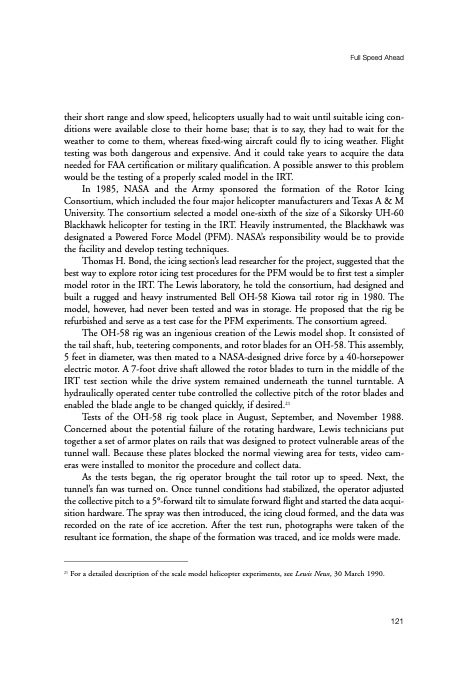
PDF Publication Title:
Text from PDF Page: 133
their short range and slow speed, helicopters usually had to wait until suitable icing con- ditions were available close to their home base; that is to say, they had to wait for the weather to come to them, whereas fixed-wing aircraft could fly to icing weather. Flight testing was both dangerous and expensive. And it could take years to acquire the data needed for FAA certification or military qualification. A possible answer to this problem would be the testing of a properly scaled model in the IRT. In 1985, NASA and the Army sponsored the formation of the Rotor Icing Consortium, which included the four major helicopter manufacturers and Texas A & M University. The consortium selected a model one-sixth of the size of a Sikorsky UH-60 Blackhawk helicopter for testing in the IRT. Heavily instrumented, the Blackhawk was designated a Powered Force Model (PFM). NASA’s responsibility would be to provide the facility and develop testing techniques. Thomas H. Bond, the icing section’s lead researcher for the project, suggested that the best way to explore rotor icing test procedures for the PFM would be to first test a simpler model rotor in the IRT. The Lewis laboratory, he told the consortium, had designed and built a rugged and heavy instrumented Bell OH-58 Kiowa tail rotor rig in 1980. The model, however, had never been tested and was in storage. He proposed that the rig be refurbished and serve as a test case for the PFM experiments. The consortium agreed. The OH-58 rig was an ingenious creation of the Lewis model shop. It consisted of the tail shaft, hub, teetering components, and rotor blades for an OH-58. This assembly, 5 feet in diameter, was then mated to a NASA-designed drive force by a 40-horsepower electric motor. A 7-foot drive shaft allowed the rotor blades to turn in the middle of the IRT test section while the drive system remained underneath the tunnel turntable. A hydraulically operated center tube controlled the collective pitch of the rotor blades and enabled the blade angle to be changed quickly, if desired.21 Tests of the OH-58 rig took place in August, September, and November 1988. Concerned about the potential failure of the rotating hardware, Lewis technicians put together a set of armor plates on rails that was designed to protect vulnerable areas of the tunnel wall. Because these plates blocked the normal viewing area for tests, video cam- eras were installed to monitor the procedure and collect data. As the tests began, the rig operator brought the tail rotor up to speed. Next, the tunnel’s fan was turned on. Once tunnel conditions had stabilized, the operator adjusted the collective pitch to a 5°-forward tilt to simulate forward flight and started the data acqui- sition hardware. The spray was then introduced, the icing cloud formed, and the data was recorded on the rate of ice accretion. After the test run, photographs were taken of the resultant ice formation, the shape of the formation was traced, and ice molds were made. Full Speed Ahead 21 For a detailed description of the scale model helicopter experiments, see Lewis News, 30 March 1990. 121PDF Image | History of NASA Icing Research Tunnel

PDF Search Title:
History of NASA Icing Research TunnelOriginal File Name Searched:
sp4226.pdfDIY PDF Search: Google It | Yahoo | Bing
NFT (Non Fungible Token): Buy our tech, design, development or system NFT and become part of our tech NFT network... More Info
IT XR Project Redstone NFT Available for Sale: NFT for high tech turbine design with one part 3D printed counter-rotating energy turbine. Be part of the future with this NFT. Can be bought and sold but only one design NFT exists. Royalties go to the developer (Infinity) to keep enhancing design and applications... More Info
Infinity Turbine IT XR Project Redstone Design: NFT for sale... NFT for high tech turbine design with one part 3D printed counter-rotating energy turbine. Includes all rights to this turbine design, including license for Fluid Handling Block I and II for the turbine assembly and housing. The NFT includes the blueprints (cad/cam), revenue streams, and all future development of the IT XR Project Redstone... More Info
Infinity Turbine ROT Radial Outflow Turbine 24 Design and Worldwide Rights: NFT for sale... NFT for the ROT 24 energy turbine. Be part of the future with this NFT. This design can be bought and sold but only one design NFT exists. You may manufacture the unit, or get the revenues from its sale from Infinity Turbine. Royalties go to the developer (Infinity) to keep enhancing design and applications... More Info
Infinity Supercritical CO2 10 Liter Extractor Design and Worldwide Rights: The Infinity Supercritical 10L CO2 extractor is for botanical oil extraction, which is rich in terpenes and can produce shelf ready full spectrum oil. With over 5 years of development, this industry leader mature extractor machine has been sold since 2015 and is part of many profitable businesses. The process can also be used for electrowinning, e-waste recycling, and lithium battery recycling, gold mining electronic wastes, precious metals. CO2 can also be used in a reverse fuel cell with nafion to make a gas-to-liquids fuel, such as methanol, ethanol and butanol or ethylene. Supercritical CO2 has also been used for treating nafion to make it more effective catalyst. This NFT is for the purchase of worldwide rights which includes the design. More Info
NFT (Non Fungible Token): Buy our tech, design, development or system NFT and become part of our tech NFT network... More Info
Infinity Turbine Products: Special for this month, any plans are $10,000 for complete Cad/Cam blueprints. License is for one build. Try before you buy a production license. May pay by Bitcoin or other Crypto. Products Page... More Info
| CONTACT TEL: 608-238-6001 Email: greg@infinityturbine.com | RSS | AMP |